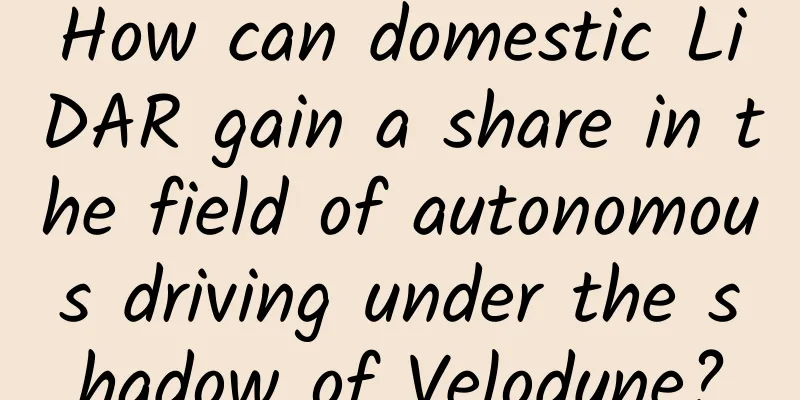How can domestic LiDAR gain a share in the field of autonomous driving under the shadow of Velodyne?

|
The World Intelligence Conference just ended held an unmanned driving competition. In this "national" technical competition led by the National Development and Reform Commission, the Ministry of Information and other ministries, each participating manufacturer brought out their own unique skills. Especially the most iconic configuration of unmanned vehicles, laser radar, previously the supplier of this sensor was almost all from an American company, Velodyne (see previous reports by Titanium Media for details). However, at this conference, the unmanned driving teams of institutions such as Beijing University of Aeronautics and Astronautics, Beijing Union University, and China Automotive Research Institute have adopted different laser radar solutions. The unmanned vehicle of China Automotive Research Institute uses the radar product of RoboSense. The company that conquered Velodyne's dominance is RoboSense, a multi-line laser radar team from Shenzhen, founded by two brothers, Qiu Chunxin and Qiu Chunchao. The elder brother Qiu Chunxin is a postdoctoral fellow at the Shenzhen Research Institute of Harbin Institute of Technology. He is a standard technical man, specializing in outdoor robot environmental perception. He is currently the CEO of RoboSense, while the younger brother Qiu Chunchao is only interested in business. He has been working in the public relations and marketing industry. He is now the CMO of RoboSense, responsible for market work. Titanium Media first contacted RoboSense through a telephone interview. At that time, we talked about Velodyne's dominance in the unmanned driving market and its penetration of many related industries such as host manufacturers, maps and academic institutions. Where are the opportunities for new entrants? RoboSense CEO Qiu Chunxin said confidently that no matter whether it is Velodyne or any other company, the technology of multi-line laser radar itself is not mature yet, and there is a lot of room for development. What's more important is that Velodyne's production capacity is in short supply, and the delivery cycle reaches 4 months. Now, as RoboSense's 16-line LiDAR product RS-LIDAR enters mass production, it has also begun to encounter this "sweet trouble". In April, RoboSense invested more than 20 production lines to start mass production of 16-line LiDAR, and now it has increased to 100 production lines. The product is priced at more than US$5,000, which is nearly 40% lower than the US$8,000 price of Velodyne's 16-line radar. The price advantage and two-week delivery cycle have made the unmanned driving industry boil. RoboSense CMO Qiu Chunchao told Titanium Media that after releasing the news that it was ready for mass production, it received more than 2,000 intention orders in two weeks. In May, they shipped 100 units. "At first we thought our production capacity was a bit redundant, but now it is completely insufficient. You can't refuse to give orders to those well-known R&D institutions, and you can't refuse to give orders to those well-known R&D institutions. School teachers say they are running an education business, so they also need to give orders to those from the military." Qiu Chunchao, CMO of RoboSense, said, "So we stopped accepting orders for a week in the second week. I need to slow down and I can't bear it anymore." Compared with the brighter commercial prospects today, RoboSense has experienced many dilemmas in its product routes and application directions along the way. From robots to unmanned driving, among unmanned driving technologies, LiDAR, millimeter-wave radar, and visual sensors are the mainstream means for sensing the surrounding environment. In terms of detection accuracy, detection distance, stability, and adaptability to climatic conditions, LiDAR has more obvious advantages. Brad Templeton, a consultant for autonomous driving at Google, once said, "99% accuracy is not enough for vehicle driving. What we need is 99.99999% accuracy. LiDAR is the strongest guarantee for several decimal places." Alon Musk, who has always been rebellious, once publicly stated that he would only use cameras and millimeter-wave radars to deploy sensors for autonomous driving. However, some media have revealed that Tesla is also using Velodyne's 64-line radar for autonomous driving tests. As a powerful tool for sensor redundancy design and precise distance measurement, the use of lidar has become a standard feature of high-level unmanned driving technology solutions. Robosense, founded in August 2014, has conquered lidar technology within three years, which is often praised by the industry. But looking back at Robosense's predecessor, it has been exploring the lidar industry for nearly 10 years. In 2007, Robosense's CEO Qiu Chunxin began to work on the perception technology of outdoor robots. Qiu Chunxin called this the earliest landing application of unmanned driving. Until the beginning of Robosense's establishment, the company's products were still focused on the familiar field of robots. They wanted to be the "eyes" of robots, which can be seen in Robosense's English name and LOGO. But the robot itself did not land well in the scene, and Robosense could not become the right water seller. "When we started the business in 2014, half of the Robosense team was working on algorithms, and half was working on hardware," said Qiu Chunxin. Starting a business in the field of robotics has allowed RoboSense to accumulate hardware, and soon it had its own single-line laser radar. RoboSense also considered looking for a map surveying company to cooperate, but surveying requires a much higher detection distance, at least 500 meters. At that time, RoboSense was making medium- and short-range detection products with a range of 100 meters. Moreover, as far as the surveying market itself is concerned, it is not larger than the imagination space of robots. RoboSense quickly adjusted its direction and chose the field of building and home decoration, which has a large enough market scale. This industry often needs to rely on scanning and modeling the environment, which is exactly what laser radar is good at. Focusing on the field of building and home decoration not only helped RoboSense achieve good revenue, but also allowed RoboSense's technology to be further precipitated in commercial applications. "After providing the laser radar device, we made 5 algorithm modules, automatic splicing, automatic extraction, automatic generation, automatic extraction of the location of sockets and floor drains, automatic production of 3D models, and evaluation of the roughness of walls." said Qiu Chunxin. Although driverless cars were detonated by Google very early, they became popular in the Chinese market around 2015. Sensing this trend, RoboSense began to turn its attention to the driverless industry in July 2015. Of course, this is also due to the fact that LiDAR technology is popular in university research, and RoboSense has attracted a lot of relevant talents in its contacts with universities. "The multi-line LiDAR we provide is not only a device, but also a matching point cloud algorithm." Qiu Chunxin told Titanium Media. This is the advantage brought by their team's genes. "Be a good supporting role for the star team of autonomous driving" Regarding whether the LiDAR team should develop algorithms, some people in the industry believe that the current LiDAR hardware itself requires too much work to do, and it is good enough to complete the product cycle. However, RoboSense has higher requirements for itself. Qiu Chunxin said that RoboSense has grown to 120 people in less than three years since its establishment, of which more than 40 are engaged in algorithm development. In Qiu Chunxin's view, it is precisely because LiDAR products are still in the primary stage that supporting algorithms need to be provided to manufacturers. Only with algorithms can standardized application rules be formed. "For example, Intel's own chips also have many underlying libraries, which is a set of software and hardware solutions." Qiu Chunxin said, "Lidar is also closely related to algorithms. If you don't do algorithms, it's hard to understand how the hardware should be done. Velodyne only provides equipment, and its equipment upgrades have been very slow in recent years. In addition, the location of its equipment and the choice of equipment solutions are very confusing. Each customer places it according to his or her own understanding of the algorithm." Qiu Chunxin, CMO in charge of the market, proposed a more concrete route, "Roboteng Juchuang is to be a 'supporting role' for star companies in autonomous driving, and to do the supporting role to the extreme, which requires a comprehensive solution for lidar from hardware to algorithms." Of course, in addition to the software and hardware integrated solution, RoboSense Juchuang, as a startup team, also has some advantages in service efficiency. Compared with Velodyne, which is located in the United States and communicates after-sales issues through emails, and some domestic lidar companies founded by academic institutions, RoboSense Juchuang will provide more timely support in installation, debugging and other product usage issues. The difficult road to mass production, stepping out of the shadow of Velodyne Just like the choice of application field, the choice of product also troubled RoboSense. Since the industry pioneer Velodyne has a relatively complete product line, covering 64 lines, 32 lines and 16 lines, RoboSense suffered a lot of external pressure when it first set the product direction. "Investors come to ask every now and then whether you want to do 32 lines or 64 lines. You have to explain everything to each person from beginning to end." Qiu Chunchao said. In fact, RoboSense also considered making a full product line and launching 64-line products like Velodyne, but found that the increase in wiring harnesses made the difficulty of adjustment and assembly soar, and the mass production time was greatly extended, which was very inconsistent with the development rhythm of entrepreneurs. "At that time, the entire founding team held a meeting to discuss the matter until 3 a.m., and no one had anything to say." Qiu Chunchao recalled, "Later, my brother sent an internal email to analyze the matter in detail. 64-line lidar is very difficult to mass produce, and if there are 100 companies in the world doing autonomous driving, perhaps 70 of them have already bought Velodyne's 64-line products. Why do you ask them to change?" In the end, in Qiu Chunxin's email, RoboSense decided on the direction, which was to make 16-line products with a relatively large market gap. However, even the 16-line products did not go smoothly in the early stages of mass production. In October 2016, RoboSense announced a mass production plan, but it was not until April this year that this promise was fulfilled. "For mobile phone production, you may get the product in 4 months if you give him a drawing, but for the production of LiDAR, we are completely exploring the process by ourselves. You may do it well today, but when the automatic production is started tomorrow, two lines will fall off, and we have to do it again." Qiu Chunchao said, "This is a very painful process, and there are only two production lines in the country that can produce LiDAR, and there is not much room for choice. Many times, we need to change it overnight. Later, we all doubted ourselves and said, have we become a process company, not a technology company." What's more embarrassing is that at that time, Velodyne acquired the automation factory in San Jose and brought mechanical LiDAR into assembly line production. The news filled the media. Against this background, the founding team of RoboSense encountered an unprecedented crisis of trust. Qiu Chunchao recalled, "At that time, engineers and technicians were directly arranged to stay in the factory to train the workers on the production line and provide guidance at the production site." It is understood that the 16-line LiDAR product currently presented to the market by RoboSense has a detection distance of 150 meters and an accuracy of 2 mm. Its performance has reached the forefront of the industry, and its price is nearly 40% lower than that of Velodyne's similar products. JD.com's unmanned delivery vehicle equipped with RoboSense LiDAR has a market strategy of mass production first, which has quickly received positive responses from RoboSense. Not long ago, JD.com held a high-profile unmanned logistics vehicle campus event, in which RoboSense's solution was used. According to Titanium Media, JD.com's demonstration points for this technology are still expanding, and the corresponding demand for radar products will also increase to hundreds of units. In addition, the procurement of some academic institutions and military projects has also become an order for RoboSense, a domestic LiDAR team. The product direction of 16-line radar has been finalized, and the bottleneck of mass production has been broken. Then there is another question. Since it is a supporting role in the autonomous driving team, can only 16-line products be provided? What if I need a 64-line product? The 16-line radar product can be used as a basic unit, and their point cloud data can be combined to realize the detection functions of more beam LiDARs. For example, four 16-line LiDARs can be combined to achieve the detection effect of 64-line LiDARs. This coupling solution has been used on the Chevrolet Bolt, a GM autonomous driving test vehicle that was recently launched. The advantage of this solution is that the product of four 16-line radars only costs more than 20,000 US dollars, while the product of 64-line laser radar needs 700,000 RMB. Of course, it is understood that there is still a gap of 1 million points between this solution (1.28 million points per second) and Velodyne's 64-line laser radar (2.2 million points). Therefore, in terms of image clarity, RoboSense's multi-laser radar is a compromise solution. Which market should be targeted? The Boston Consulting Group of the United States has made a prediction that the market value created by driverless cars will reach 42 billion US dollars. The market of driverless cars is so large that every link in its chain can form an industrial chain, especially products like laser radar that occupy the throat of the industry. With the route guidance of landing first, RoboSense has a relatively clear choice in the face of this vast market. "The first to land is definitely low-speed autonomous driving in closed parks, including buses, mining cars, and delivery trucks on sparsely populated highways." Qiu Chunchao said, "I think this is a step-by-step process." RoboSense's market application direction also targets the fields of low-speed autonomous driving and closed autonomous driving. Domestic companies including UISEE Technology, which is positioned in park autonomous driving, TuSimple, a truck autonomous driving team, and Zhixingche and Zhizunbao, commercial vehicle autonomous driving teams, have close ties with RoboSense and are considering its product solutions. TuSimple adopts RoboSense's coupling solution. Of course, choosing tool vehicles as the landing field also has a contradiction between the requirements of the passenger car market and the current status of LiDAR products. A Bosch autonomous driving product manager once told Titanium Media that the current LiDAR products on the market do not meet the requirements according to Bosch's standards, as well as automotive standards such as high temperature resistance and vibration. Qiu Chunchao also bluntly stated that the first problem to be faced when discussing cooperation with Tier1 and OEMs is, "This solution is to be used in mass-produced passenger cars. Can you pass the automotive regulations and ensure safety?" For tool vehicles, such requirements will be much more relaxed. However, Qiu Chunchao also said that in two years, it will be much easier for LiDAR products to pass automotive regulations. It is not that the current LiDAR process will be mature, but that another new set of technologies, solid-state LiDAR, will come out. As a future market leader, RoboSense has invested in a team in Silicon Valley to develop solid-state LiDAR with phased array technology. The first phase of the demo will be launched in the first quarter of next year, and mass production will be launched in 2019. This phased array technology LiDAR emits interference waves through the internal antenna and synthesizes the main beam to detect the surrounding environment. The internal structure is extremely simplified, and no mechanical structures such as transmitters, receivers, and rotating motors used in current LiDARs are required. Therefore, it will be much easier to inspect, adjust, and install the vehicle-grade LiDAR, and the price will naturally drop significantly. Quanergy, the earliest foreign company to develop solid-state LiDAR, has promised that the cost of a single solid-state LiDAR will drop to $100 when it is mass-produced in 2018. Some of the star domestic autonomous driving startup teams, such as Tusen Future and Yushi Technology, have also begun to work closely with RoboSense based on this. Although RoboSense has experienced difficulties in every stage of the company's development, it has stepped on the right steps, which has also made RoboSense gain high expectations in the capital market. According to public information, RoboSense has completed three rounds of financing totaling tens of millions of yuan in the three years since its establishment, with a valuation of 1 billion yuan. According to Qiu Chunchao, a new round of financing of nearly 100 million yuan will be closed soon. As a domestic LiDAR team that has broken through the current situation, RoboSense has a solid product foundation and a future-oriented market layout. I believe it can also gain greater opportunities with the help of the domestic autonomous driving market. As a winner of Toutiao's Qingyun Plan and Baijiahao's Bai+ Plan, the 2019 Baidu Digital Author of the Year, the Baijiahao's Most Popular Author in the Technology Field, the 2019 Sogou Technology and Culture Author, and the 2021 Baijiahao Quarterly Influential Creator, he has won many awards, including the 2013 Sohu Best Industry Media Person, the 2015 China New Media Entrepreneurship Competition Beijing Third Place, the 2015 Guangmang Experience Award, the 2015 China New Media Entrepreneurship Competition Finals Third Place, and the 2018 Baidu Dynamic Annual Powerful Celebrity. |
<<: What can UCloud do to accelerate Chinese companies’ overseas expansion?
>>: Foreign media: China's electric cars are actually very dirty
Recommend
Uber burns too much money in China, investors call for peace with Didi
Investors in ride-hailing service Uber have a mes...
Didi Kuaidi’s valuation reaches US$15 billion. Is this a capital game or a reflection of value?
Just after Uber announced that it had raised $1 b...
How to plan a successful operation event (online event version)
“Online activities refer to activities that rely ...
United Nations Diabetes Day | A Century of Insulin in China
Insulin was discovered in 1921 and is considered ...
Review of the method of making a poster that can increase the number of fans per day, and a practical growth strategy
Before talking about the logic of fission posters...
The weather is so hot, don't waste your sweat! Experts: Go generate electricity
Hi, my lovely “academic bacteria”, I am your love...
The National Day routine is here, I won’t tell ordinary people about it!
The annual National Day holiday is coming! Are yo...
Liu Xuan’s personal information: How to improve website weight and master optimization tips?
With the popularization of the Internet, online p...
How to become a data analyst in seven weeks: Data visualization and building BI step by step
The report that data analysts use more often is B...
After the first half of the price war, Chery Automobile learned to respond quickly and began to study its suppliers.
The first half of China's new energy vehicle ...
Yang Kai's half-year video course on institutional trading strategy improvement class from June to December 2021
Yang Kai's half-year video course on institut...
NIO: November 2020 deliveries set a new record, doubling year-on-year for eight consecutive months
On December 1, 2020, NIO just released NIO's ...
Mastering the tips when exercising can easily lower your blood pressure. Learn these 5 techniques quickly!
High blood pressure is like a slow knife, lurking...
Android Wear is also about to be upgraded to 5.0, and the watch face display mode is turned on
In this era of personalization, you may also thin...
Why are the internal pages of the website not included? Why doesn't Baidu include my website?
In the process of website optimization, I believe...









